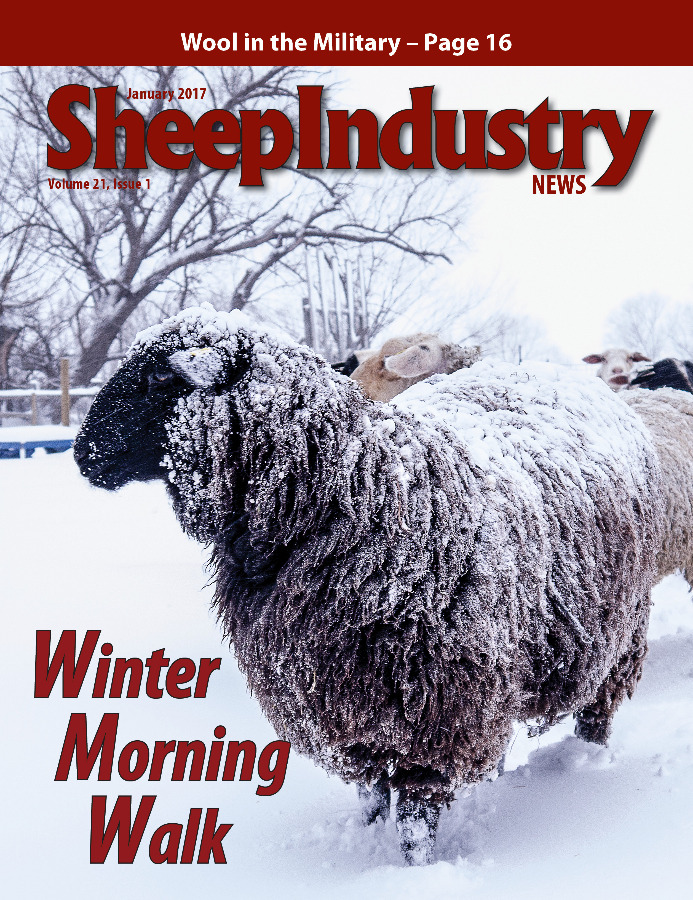To View the January 2017 Digital Issue — Click Here

Transitioning Priorities in Washington, D.C.
Burton Pfliger, ASI President
As of press time – just before Christmas – we are completing a letter to President-Elect Trump with recommendations that would benefit sheep farms and ranches nationwide.
We hope the transition team will review and select issues to address from recent regulations to long-term challenges facing the American sheep industry. We are working to keep the list manageable with high-impact, yet important topics we hope will interest the new administration to improve American business and our contribution to the economy.
Here are the topics covered in the letter:
• Increased agency requests for funding for U.S. Department of Agriculture/Animal and Plant Health Inspection Service Wildlife Services predation management. Every dollar spent on predation management returns three dollars in livestock value saved. This has a tremendous impact on sheep and cattle producers and the rural economies they support.
• Maintain the U.S. Sheep Experiment Station and support the merger of the USSES and the Animal Disease Research Unit to sustain and grow their roles in food-animal science, rangeland systems and animal health programs.
• Publish the USDA/APHIS final rule on scrapie in sheep and goats with ASI recommendations. The amendments to this rule proposed by APHIS have been carefully considered and are appropriate. We are currently awaiting USDA/APHIS’s review of comments and publication of the final rule.
• Immediate withdrawal of USDA/APHIS rule on Importation of Bone-In Ovine Meat from Uruguay. While ASI is a proponent of free and fair trade, this rule does not recognize Uruguay’s history of Foot and Mouth Disease and relies on an outdated and insufficient risk assessment.
• Amend Current Mandatory Price Reporting to include cooperatives and provide confidentiality of prices reported. Like all segments of agriculture, the American sheep industry has experienced considerable processor consolidation in the past decade. Our producers rely on accurate, timely price information to make marketing decisions. Reporting is in the best interest of all marketplace participants, especially sheep producers. Additionally, approximately 30 percent of lambs are currently processed by one cooperative, however, due to the intricacies of their business model and USDA’s internal and antiquated rules, USDA does not allow cooperative structures to be fully included in Livestock Mandatory Reporting.
• Immediate withdrawal of the 2012 National Forest Service Land Management Planning rule and any reference to “species viability.” The forest planning rule exceeds the intent of Congress to manage the nation’s forests. Moreover, “single species viability” as called for in the rule cannot be allowed to supersede all legal obligations for multiple use of federal lands, including grazing. Species viability, as implemented by the current administration, ignores historical habitat and enforces non-natural restraints on rangelands. Prior to any decision involving the proposed removal of domestic sheep allotments in preference to bighorn sheep habitat, we ask that the administration require sound-science and consultation with ARS. And, should such a decision be found scientifically warranted, that alternative equal allotment(s) be offered.
• Immediate withdrawal of Department of Interior Bureau of Land Management Policy 1730 – Management of Domestic Sheep and Goats to Sustain Wild Sheep. This guidance is based on flawed science and has led to a number of domestic sheep producers being removed from their allotments. Domestic sheep and bighorns have co-existed in many of the same areas for decades without significant impact to bighorn herds. There is no single, identifiable pathogen responsible for the most common respiratory diseases in bighorns that can clearly be tied to contact with domestic sheep on the open range.
• De-list the grizzly bear and all species of wolves nationwide under the Endangered Species Act and return management of these species to state governments. The populations of these species have returned to appropriate levels and continued federal protection under the ESA is no longer warranted. The current lack of state management of these species threatens the viability of the livestock and the greater wildlife ecosystem in these habitat areas, hampering our ability in the West to provide domestic food and recreation.
We might have an additional topic or two in the final letter as sheep producer leaders continue to weigh in on the priorities. The final version will be posted at Sheepusa.org for your review. I believe it is a proactive approach to put our key issues in front of political leaders and create changes that are desperately needed.
We hope to have feedback on our conversation with the new administration at our January convention.
I also want to comment in my conversation with you this month about the article in the November issue regarding the new staff and contractors ASI has brought on board this fall. We work our non-dues budgets and fundraising very diligently to line up funds and priorities to be able to attract sharp people to further the sheep industry. The timing is right with ASI budgets and priorities to add staff and take a more aggressive approach to handling issues from wool to communications to resource management and environmental issues. I am pleased to have more resources on board, and look forward to the accomplishments in 2017.


